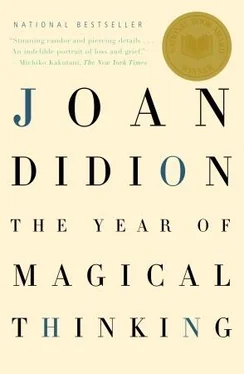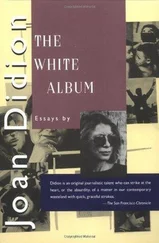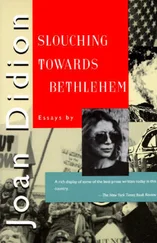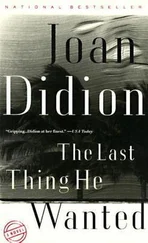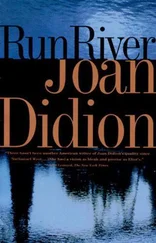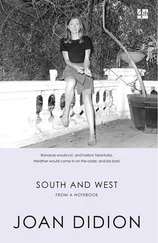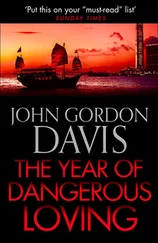In my rational mind I knew that.
I was not however operating from my rational mind.
Had I been operating from my rational mind I would not have been entertaining fantasies that would not have been out of place at an Irish wake. I would not for example have experienced, when I heard that Julia Child had died, so distinct a relief, so marked a sense that this was finally working out: John and Julia Child could have dinner together (this had been my immediate thought), she could cook, he could ask her about the OSS, they would amuse each other, like each other. They had once done a breakfast together, in a season when each was promoting a book. She had inscribed a copy of The Way to Cook and given it to him.
I found the copy of The Way to Cook in the kitchen and looked at the inscription.
“ Bon appetit to John Gregory Dunne,” it read.
Bon appetit to John Gregory Dunne and Julia Child and the OSS.
Nor, had I been operating from my rational mind, would I have given such close attention to “health” stories on the Internet and pharmaceutical advertising on television. I fretted for example over a Bayer commercial for a low-dose aspirin that was said to “significantly reduce” the risk of a heart attack. I knew perfectly well how aspirin reduces the risk of heart attack: it keeps the blood from clotting. I also knew that John was taking Coumadin, a far more powerful anticoagulant. Yet I was seized nonetheless by the possible folly of having overlooked low-dose aspirin. I fretted similarly over a study done by UC — San Diego and Tufts showing a 4.65 percent increase in cardiac death over the fourteen-day period of Christmas and New Year’s. I fretted over a study from Vanderbilt demonstrating that erythromycin quintupled the risk of cardiac arrest if taken in conjunction with common heart medications. I fretted over a study on statins, and the 30 to 40 percent jump in the risk of heart attack for patients who stopped taking them.
As I recall this I realize how open we are to the persistent message that we can avert death.
And to its punitive correlative, the message that if death catches us we have only ourselves to blame.
Only after I read the autopsy report did I begin to believe what I had been repeatedly told: nothing he or I had done or not done had either caused or could have prevented his death. He had inherited a bad heart. It would eventually kill him. The date on which it would kill him had already been, by many medical interventions, postponed. When that date did come, no action I could have taken in our living room — no home defibrillator, no CPR, nothing short of a fully equipped crash cart and the technical facility to follow cardioversion within seconds with IV medication — could have given him even one more day.
The one more day I love you more than.
As you used to say to me.
Only after I read the autopsy report did I stop trying to reconstruct the collision, the collapse of the dead star. The collapse had been there all along, invisible, unsuspected.
Greater than 95 percent stenosis of both the left main and the left anterior descending arteries.
Acute infarct in distribution of left anterior descending artery, the LAD.
That was the scenario. The LAD got fixed in 1987 and it stayed fixed until everybody forgot about it and then it got unfixed. We call it the widowmaker, pal, the cardiologist had said in 1987.
I tell you that I shall not live two days, Gawain said.
When something happens to me, John had said.
Ihave trouble thinking of myself as a widow. I remember hesitating the first time I had to check that box on the “marital status” part of a form. I also had trouble thinking of myself as a wife. Given the value I placed on the rituals of domestic life, the concept of “wife” should not have seemed difficult, but it did. For a long time after we were married I had trouble with the ring. It was loose enough to slip off my left ring finger, so for a year or two I wore it on my right. After I burned the right finger taking a pan from the oven, I put the ring on a gold chain around my neck. When Quintana was born and someone gave her a baby ring I added her ring to the chain.
This seemed to work.
I still wear the rings that way.
“You want a different kind of wife,” I frequently said to John in the first years of our marriage. I usually said this on the way back to Portuguese Bend after dinner in town. It was typically the initial volley in those fights that started as we passed the refineries off the San Diego Freeway. “You should have married someone more like Lenny.” Lenny was my sister-in-law, Nick’s wife. Lenny entertained and had lunch with friends and ran her house effortlessly and wore beautiful French dresses and suits and was always available to look at a house or give a baby shower or take visitors from out of town to Disneyland. “If I wanted to marry someone more like Lenny I would have married someone more like Lenny,” John would say, at first patiently, then less so.
In fact I had no idea how to be a wife.
In those first years I would pin daisies in my hair, trying for a “bride” effect.
Later I had matching gingham skirts made for me and Quintana, trying for “young mother.”
My memory of those years is that both John and I were improvising, flying blind. When I was clearing out a file drawer recently I came across a thick file labeled “Planning.” The very fact that we made files labeled “Planning” suggests how little of it we did. We also had “planning meetings,” which consisted of sitting down with legal pads, stating the day’s problem out loud, and then, with no further attempt to solve it, going out to lunch. Such lunches were festive, as if to celebrate a job well done. Michael’s, in Santa Monica, was a typical venue. In this particular “Planning” file I found several Christmas lists from the 1970s, a few notes on telephone calls, and, the bulk of the file, many notes, again dating from the 1970s, having to do with projected expenses and income. A mood of desperation permeates these notes. There was a note made for a meeting with Gil Frank on April 19, 1978, when we were trying to sell the house in Malibu to pay for the house in Brentwood Park on which we had already put down a $50,000 deposit. We could not sell the house in Malibu because it rained all that spring. Slopes fell. The Pacific Coast Highway was closed. No one could even look at the house unless they already lived on the Malibu side of the washout. Over a period of some weeks we had only one viewer, a psychiatrist who lived in the Malibu Colony. He left his shoes outside in the driving rain to “get the feel of the house,” walked around barefoot on the tile floor, and reported to his son, who reported to Quintana, that the house was “cold.” This was the note made on April 19 of that year: We must assume we will not sell Malibu until end of year. We have to assume the worst so that any improvement will seem better.
A note made a week later, I can only think for a “planning meeting”: Discuss: Abandon Brentwood Park? Eat the $50,000?
Two weeks later we flew to Honolulu, thinking to escape the rain and sort out our dwindling options. The next morning when we came in from swimming there was a message: the sun had come out in Malibu and we had an offer within range of the asking.
What had encouraged us to think that a resort hotel in Honolulu was the place to solve a cash shortfall?
What lesson did we take from the fact that it worked?
Twenty-five years later, confronted with a similar shortfall and similarly deciding to sort it out in Paris, how could we have seen it as economizing because we got one ticket free on the Concorde?
Читать дальше
Конец ознакомительного отрывка
Купить книгу
